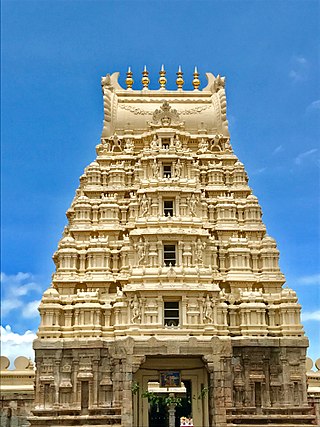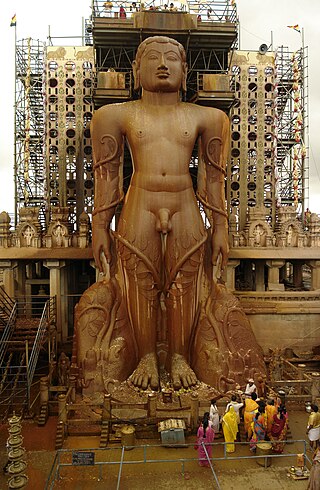
Srirangapatna is a town and headquarters of one of the seven Taluks of Mandya district, in the Indian State of Karnataka. It gets its name from the Ranganthaswamy temple consecrated at around 984 CE. Later, under the British rule the city was renamed to Seringapatnam. Located near the city of Mandya, it is of religious, cultural and historic importance.
Mulabagilu is a town and taluk headquarters of Mulabagilu taluk in the Kolar district in the state of Karnataka, India. It lies just off the National Highway 75 as the easternmost town of the state and a hill landmark.

Devanahalli, also called "Devandahalli", "Dyaavandalli", Devanadoddi, and Devanapura, is a town and Town Municipal Council in Bengaluru Rural district in the state of Karnataka in India. The town is located 40 kilometres (25 mi) to the north-east of Bengaluru. Devanahalli is the site of Kempegowda International Airport. A multibillion-dollar Devanahalli Business Park with two IT Parks are coming up on nearly 400 acres (1.6 km2) adjoining the airport. An Aerospace Park, Science Park and a ₹10 billion (US$130 million) Financial City are also coming up. A new satellite ring road will connect the city with Doddaballapur. Devanahalli is situated near the upcoming ₹1,500 billion (US$19 billion), 12,000-acre (49 km2) BIAL IT Investment Region, to be the largest IT region in India.

Melukote in Pandavapura taluk of Mandya district, Karnataka, in southern India, is one of the sacred places in Karnataka.It is built on rocky hills, known as Yadugiri, Yaadavagiri and Yadushailadeepa, overlooking the Cauvery valley. Melukote is about 51 km from Mysore and 133 km (83 mi) from Bangalore.

Kengeri is a suburb in Bangalore city. It is located on the western corridor along Mysore Road, bordered by Nagarbhavi to the north,Rajarajeshwari Nagar to the east and Uttarahalli to the south.
Kunigal is a town in Tumakuru district in the Indian state of Karnataka. It is the headquarters of Kunigal taluk. As of 2011 census, the town has a population of 34155.

Magadi is a Taluk headquarters located in Ramanagara district. The town is situated at a distance of 51 km from Bangalore. The founder of Bangalore, the great Kempegowda was a native of Kempapura, Magadi taluk. Magadi, having a rich cultural heritage was the largest boundary marked during the rulers of Vijayanagar empire. The town was earlier known by names Maha Gadi or Mahalakshmi Gadi, later the British regime renamed the town as Magadi. Magadi is also home to a popular Plywood Brand "Raajply"

Karnataka, the sixth largest state in India, has been ranked as the third most popular state in the country for tourism in 2014. It is home to 507 of the 3600 centrally protected monuments in India, second only to Uttar Pradesh. The State Directorate of Archaeology and Museums protects an additional 752 monuments and another 25,000 monuments are yet to receive protection.

Ramanagara district, is one of the 31 districts of Karnataka state in southern India. Ramanagara City is the administrative headquarters of this district. The district is part of Bengaluru Division.

Bangalore Fort began in 1537 as a mud fort. The builder was Kempe Gowda I, a vassal of the Vijaynagar Empire and the founder of Bangalore. Hyder Ali in 1761 replaced the mud fort with a stone fort and it was further improved by his son Tipu Sultan in the late 18th century. It was damaged during an Anglo-Mysore war in 1791. It still remains a good example of 18th-century military fortification. The army of the British East India Company, led by Lord Cornwallis on 21 March 1791 captured the fort in the siege of Bangalore during the Third Mysore War (1790–1792). At the time the fort was a stronghold for Tipu Sultan. Today, the fort's Delhi gate, on Krishnarajendra Road, and two bastions are the primary remains of the fort. A marble plaque commemorates the spot where the British breached fort's wall, leading to its capture. The old fort area also includes Tipu Sultan's Summer Palace, and his armoury. The fort has provided the setting for the treasure hunt in the book Riddle of the Seventh Stone.
Bangalore (Bengaluru), the capital of Karnataka state, India, reflects its multireligious and cosmopolitan character by its more than 1000 temples, 400 mosques, 100 churches, 40 Jain derasars, three Sikh gurdwaras, two Buddhist viharas and one Parsi fire temple located in an area of 741 km2 of the metropolis. The religious places are further represented to include the few members of the Jewish community who are making their presence known through the Chabad that they propose to establish in Bengaluru and the fairly large number of the Baháʼí Faith whose presence is registered with a society called the Baháʼí Centre. In the demographically diverse, major economic hub and India's fastest-growing major metropolis of Bengaluru, the number of religious places of each religion reported reflects growth in proportion to the population growth. According to the 2001 census of India, 79.37% of Bangalore's population is Hindu, roughly the same as the national average. Muslims comprise 13.37% of the population, which again is roughly the same as the national average, while Christians and Jains account for 5.79% and 1.05% of the population, respectively, double that of their national averages. Anglo-Indians also form a substantial group within the city.

Hutridurga, also known as Uttari Betta is a fortified hill in the south-east of Kunigal taluk, rising to 3708 feet above the sea level that is located 15km south-easterly to Kunigal, the Taluk centre. Hutridurga is situated about 65 km west of Bengaluru in the state of Karnataka, in Kunigal taluk, Tumakuru district. It is situated off the Kunigal-Magadi state highway (SH94), at a distance of about 7 km from it and 10 km from the Anchepalya industrial area on the Bengaluru-Mangalore National Highway (India) - NH48 near Kunigal.

Bilikal Ranganatha Swamy Betta is a hill near Kanakapura town in the Indian state of Karnataka. It is located 70 km south of Bangalore city. Atop the hill is a temple dedicated to Lord Ranganatha Swamy. The temple and an adjacent quarters is housed underneath a huge granite rock. The hill is also known by the name Billikal Betta due to the whitish rocks near the summit that is visible from a long distance. The peak is at a height of 3780 feet.

Shivagange is a mountain peak with a height of 1,368 metres (4,488 ft) and Hindu pilgrimage center located near Dobbaspet, in Bengaluru Rural district India. It is 25 km (16 mi) from the town of Tumakuru and 54 km (34 mi) from Bengaluru. The sacred mountain is shaped as a shivalinga and a spring flows near locally called "Ganga", thereby giving the place its name. It is also known as Dakshina Kashi and has various temples such as Gangadhareshwara temple, Sri Honnammadevi Temple, Olakal Teertha, Nandi Statue, Patalagang Sharadambe temple and several theerthas such as Agasthya theertha, Kanva theertha, Kapila theertha, Pathala Gange

Sankighatta, The name comes from Settra + Ghatta = Settraghatta and is pronounced as Sankighatta. In Kannada language Settra + Ghatta (Place) literal meaning is ""place of Settru"". Dallina Vardaman Mahaveera Thirtankara is the Lord Mahaveer Swamy Jain Basadi/temple in Karnataka, south India. Sankighatta was a historic Jain center and was under the control of Settru family, the Samantha Rajas. They also controlled surrounding places like Kalya, Kunigal, Magadi, Savandurga, Hebbur, Mayasandra, Settikere, Veerasagara, Srigiripura, Shivaganga hills, Biskuru, etc..

The Ranganatha Swamy and the Someshwara temples are located in the historic town of Magadi, about 41 km from Bangalore, the capital of the Indian state of Karnataka. These temples are protected monuments under the Karnataka state division of the Archaeological Survey of India.

The Gunja Narasima Swamy Temple is a Hindu temple in Tirumakudal Narasipura, a town in the Mysore district, Karnataka state, India. The town is located 20 miles south east of the historically important city of Mysore. The temple dates back to about the 16th rule of the Vijayanagara empire and is built in typical dravidian style with an imposing gopura (tower) over the entrance gate (mahadwara) and a four pillared mantapa ("hall") in front of the sanctum. The temple is located at the confluence of the Kaveri river and the Kabini river and is considered sacred by Hindus. The temple gets its name from the Gunja(Gulaganji in Kannada) tree that grows in the front of the main entrance; a boastful local claim is that the temple is more sacred than Varanasi (Kashi) by the weight of a gunja plant. Sculptures in the temple include those of the Hindu god Narasimha and the demon King Hiranyakashipu.

The Narasimha Swamy temple at Seebi is located in the Tumkur taluk of Tumkur district, in the Indian state of Karnataka. Seebi is located on National Highway 4, just 20 km north of Tumkur city.
Manchinabele is a village in Magadi taluk in Ramanagara District, 40 km away from Bangalore city. It has a population of 1098 according to 2011 census.





















